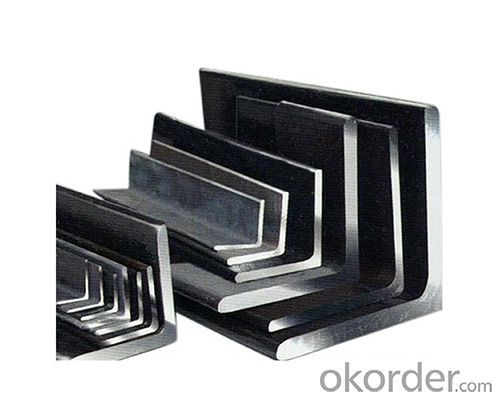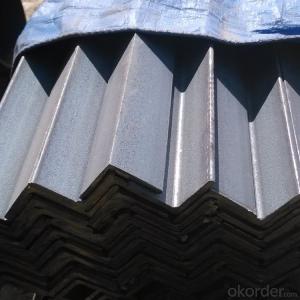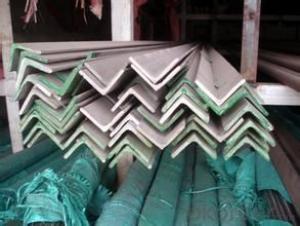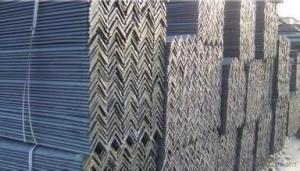EN10056 galvanized angle steel for construction
- Loading Port:
- Tianjin
- Payment Terms:
- TT OR LC
- Min Order Qty:
- 25 m.t.
- Supply Capability:
- 10000 m.t./month
OKorder Service Pledge
OKorder Financial Service
You Might Also Like
Product Description:
Specifications of Equal Angle Steel
1.Standards:GB
2.Length:6m, 12m
3.Material:GBQ235, Q345 or Equivalent
4. Size:
Size (mm) | Mass (mm) | Size (mm) | Mass (mm) |
| 30*30*2.7 | 1.246 | 30*30*4 | 1.786 |
| 30*30*3.0 | 1.373 | 30*30*5 | 2.184 |
Usage & Applications of Equal Anlge Steel
Trusses;
Transmission towers;
Telecommunication towers;
Bracing for general structures;
Stiffeners in structural use.
Packaging & Delivery of Equal Angle Steel
1. Transportation: the goods are delivered by truck from mill to loading port, the maximum quantity can be loaded is around 40MTs by each truck. If the order quantity cannot reach the full truck loaded, the transportation cost per ton will be little higher than full load.
2. With bundles and load in 20 feet/40 feet container, or by bulk cargo, also we could do as customer's request.
3. Marks:
Color mark: There will be color marking on both end of the bundle for the cargo delivered by bulk vessel. That makes it easily to distinguish at the destination port.
Tag mark: There will be tag mark tied up on the bundles. The information usually including supplier logo and name, product name, made in China, shipping marks and other information request by the customer.
If loading by container the marking is not needed, but we will prepare it as customers' request.
*If you would like to get our price, please inform us the size, standard/material and quantity. Thank you very much for your attention


- Q:What are the common surface treatments used for steel angles?
- Steel angles can be treated with various surface treatments such as galvanizing, painting, and powder coating. Galvanizing involves applying a layer of zinc to the steel angle to prevent corrosion. This can be done by immersing the angle in molten zinc or using a specialized technique. Galvanized angles have a shiny, silver appearance and offer excellent resistance against corrosion. Painting is another option for treating steel angles. The angle is typically primed and then coated with one or more layers of paint. This not only enhances the angle's appearance but also provides protection against rust and environmental factors. Painting allows for a wide range of colors and finishes, making it versatile for different applications. Powder coating is a dry finishing process where a fine powder made of resin and pigment is electrostatically applied to the angle's surface. The angle is then heated, causing the powder to melt and form a durable coating. Powder coating offers excellent resistance to scratches, chemicals, and UV rays. It is available in various colors and provides a smooth and even finish. The choice of surface treatment for steel angles depends on the specific application and the desired level of protection, aesthetics, and durability. Galvanizing is suitable for outdoor or corrosive environments, while painting and powder coating are commonly used indoors or when a specific color or finish is desired.
- Q:What are the different surface treatments available for galvanized steel angles?
- To enhance the appearance, durability, and resistance to corrosion of galvanized steel angles, there are various surface treatments available. Some commonly used treatments include: 1. Powder coating: This method involves applying a dry powder onto the surface of the galvanized steel angle, followed by heating to create a long-lasting and visually appealing finish. Powder coating can be customized to achieve different colors and textures, resulting in a high-quality surface treatment. 2. Painting: Galvanized steel angles can also be painted with different coatings, such as epoxy, polyurethane, or enamel paint. Painting adds an extra layer of protection against corrosion and can be tailored to meet specific aesthetic requirements. 3. Hot-dip galvanizing: This treatment is the initial process for galvanized steel angles. It involves immersing the angles in a bath of molten zinc, which forms a protective layer on the surface. Hot-dip galvanizing offers excellent corrosion resistance and is particularly suitable for outdoor applications. 4. Zinc electroplating: Similar to hot-dip galvanizing, zinc electroplating applies a thin layer of zinc to the steel angle's surface through an electrochemical process. This treatment offers good corrosion protection and can be combined with other surface treatments to enhance durability. 5. Anodizing: Anodizing is commonly used for aluminum surfaces but can also be applied to galvanized steel angles. This process creates a controlled oxide layer on the surface, improving corrosion resistance and providing a decorative finish. 6. Passivation: Passivation is a chemical treatment that eliminates iron and other impurities from the surface of galvanized steel angles. It enhances the steel's corrosion resistance by creating a passive oxide layer. When selecting a surface treatment for galvanized steel angles, it is crucial to consider specific application requirements, budget constraints, and desired aesthetic appearance. Seeking advice from professionals or suppliers can help determine the most suitable treatment for your needs.
- Q:What are the common sizes of steel angles?
- The sizes of steel angles can differ based on the industry and specific project requirements. However, there are several standard sizes that are commonly utilized. In the United States, the most readily accessible steel angles are available in widths of 1/2 inch, 1 inch, 1-1/2 inches, and 2 inches. Typically, these angles have thicknesses ranging from 1/8 inch to 1/4 inch. Furthermore, larger and smaller angles can also be found for specialized applications. These specialized angles may include wider angles measuring up to 8 inches or more, or thinner angles with thicknesses as low as 1/16 inch. It is important to acknowledge that these sizes might vary in different countries or regions, and suppliers may have their own specific range of sizes. Thus, it is advisable to consult with local suppliers or manufacturers to determine the most prevalent sizes of steel angles in a particular area.
- Q:What is the minimum thickness for a steel angle?
- The minimum thickness for a steel angle typically depends on the specific application and the load it needs to bear. However, in general, steel angles are available in various thicknesses ranging from 1/8 inch to 1 inch or more.
- Q:What is the standard length of a steel angle?
- The specific requirements and industry or project standards can lead to variations in the standard length of a steel angle. Typically, steel angles are readily accessible in standard lengths of 20 feet or 6 meters. These standard lengths facilitate transportation, handling, and installation. Nevertheless, it is worth mentioning that custom lengths can also be manufactured to fulfill project-specific requirements.
- Q:Can steel angles be used in HVAC systems?
- Yes, steel angles can be used in HVAC systems. They are often used as supports, brackets, or framing components in the installation of air conditioning units, ductwork, and other HVAC equipment. Steel angles provide strength, stability, and durability, making them suitable for various applications within HVAC systems.
- Q:What is the difference between galvanized steel angle and ordinary angle iron?
- Ordinary steel angle and cold galvanized steel angle per ton difference of about 500 yuan;
- Q:How are steel angles inspected for quality and compliance with standards?
- Steel angles are inspected for quality and compliance with standards through a series of rigorous tests and visual inspections. These inspections include dimensional checks, visual examination for surface defects, and verification of mechanical properties such as tensile strength and yield strength. Additionally, the angles are subjected to non-destructive testing methods such as ultrasonic and magnetic particle testing to detect any internal flaws or defects. Compliance with standards is ensured by comparing the test results with the specified requirements outlined in the relevant standards and specifications.
- Q:How are steel angles protected against fire damage?
- Steel angles can be protected against fire damage through the application of fire-resistant coatings or by encasing them in fireproof materials such as concrete or gypsum board. Additionally, fireproofing sprays or intumescent paints can also be used to provide a layer of insulation that helps to slow down the spread of fire and protect the steel angles from excessive heat.
- Q:Can steel angles be used in mining or offshore applications?
- Mining or offshore applications can utilize steel angles. These industries often rely on steel angles for their robustness, longevity, and adaptability. Steel angles are employed for an array of functions, including framing, support, reinforcement, and bracing in mining structures and offshore platforms. Moreover, steel angles possess the capability to endure harsh environments, adverse weather conditions, and corrosive elements frequently encountered in mining or offshore operations. Their capacity to offer structural stability and withstand impact and vibrations renders them well-suited for these applications. All in all, steel angles present a dependable and economically viable option for the mining and offshore sectors.
1. Manufacturer Overview |
|
|---|---|
| Location | |
| Year Established | |
| Annual Output Value | |
| Main Markets | |
| Company Certifications | |
2. Manufacturer Certificates |
|
|---|---|
| a) Certification Name | |
| Range | |
| Reference | |
| Validity Period | |
3. Manufacturer Capability |
|
|---|---|
| a)Trade Capacity | |
| Nearest Port | |
| Export Percentage | |
| No.of Employees in Trade Department | |
| Language Spoken: | |
| b)Factory Information | |
| Factory Size: | |
| No. of Production Lines | |
| Contract Manufacturing | |
| Product Price Range | |
Send your message to us
EN10056 galvanized angle steel for construction
- Loading Port:
- Tianjin
- Payment Terms:
- TT OR LC
- Min Order Qty:
- 25 m.t.
- Supply Capability:
- 10000 m.t./month
OKorder Service Pledge
OKorder Financial Service
Similar products
New products
Hot products
Related keywords




























